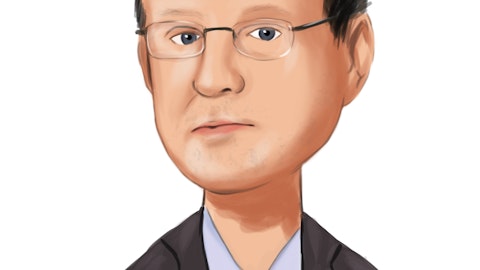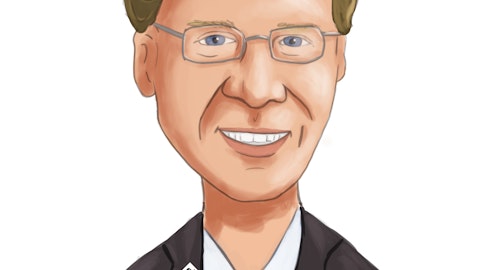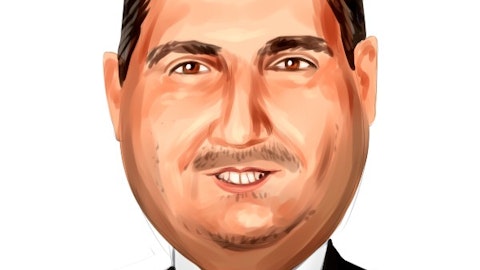Ameris Bancorp (NASDAQ:ABCB) Q4 2023 Earnings Call Transcript January 26, 2024
Ameris Bancorp isn’t one of the 30 most popular stocks among hedge funds at the end of the third quarter (see the details here).
Operator: Good day, and welcome to the Ameris Bancorp Fourth Quarter Conference Call. All participants will be in a listen-only mode. [Operator Instructions] Please note this event is being recorded. I would now like to turn the conference over to Ms. Nicole Stokes, Chief Financial Officer. Please go ahead, ma’am.
Nicole Stokes: Thank you, Chuck and thank you to all who have joined our call today. During the call, we will be referencing the press release and the financial highlights that are available on the Investor Relations section of our website at amerisbank.com. I’m joined today by Palmer Proctor, our CEO; Jon Edwards, our Chief Credit Officer; and Doug Strange, our Managing Director of Credit who will be taking over for Jon when he retires at the end of this quarter. Palmer will begin today with some general opening comments and then I will begin to discussing the details of our financial results before we open up for Q&A. Before we begin, I’ll remind you that our comments may include forward-looking statements. These statements are subject to risks and uncertainties.
The actual results could vary materially. We list some of the factors that might cause results to differ in our press release and in our SEC filings, which are available on our website. We do not assume any obligation to update any forward-looking statements as a result of new information, early developments or otherwise, except as required by law. Also during the call, we will discuss certain non-GAAP financial measures in reference to the company’s performance. You can see our reconciliation of these measures and GAAP financial measures in the appendix to our presentation. And with that, I’ll turn it over to Palmer for opening comments.
Palmer Proctor: Thank you, Nicole and good morning everyone. I appreciate you taking the time to join our call today. I’m very pleased with the financial results, we reported yesterday, and I’m excited to be able to share some of the highlights in our overall strategic view for 2024 before Nicole gets into some of the financial details. 2023 was certainly a year of discipline and resilience for our company and the fourth quarter was a solid close to our plan. Throughout the year, we focused on strengthening the balance sheet to prepare ourselves for 2024 with a healthy margin, strong capital, and increased reserves. We grew deposits this year by over 6% and then controlled loan growth of 2%, improving our loan-to-deposit ratio to 98%, all while maintaining an above-peer net interest margin of 3.61% for the year.
During the fourth quarter, we recorded $23 million provision for credit losses, bringing our year-to-date provision expense to over $142 million and that improves our coverage ratio up to 1.52% of loans and 365% of portfolio NPAs. And once again, this provisioning was model-driven and not related to any credit deterioration. We built and preserved capital this year such that our TCE ratio is well over our stated goal of 9% and we also grew tangible book value by over 12% this year. So, as we move into 2024, a lot of the confidence that we have is based on several factors. First, we have and will continue to fight to protect our margin and we’re starting the year from a position of strength there, fortunately. We also have, as you know, a very granular deposit base, a very sticky deposit base.

And then when you combine that with a well-capitalized balance sheet and a healthy allowance and obviously, as we’ve proven a culture of expense control, we also have a diversified revenue stream that generates above peer PPNR ROA. And last but not least, what gives us a lot of comfort too is just knowing that we have established individuals and a lot of the top growth markets throughout the Southeast. So, when it’s appropriate to accelerate growth, we can do so. So, a lot of those are the main things that give us a lot of positive outlook as we look through the remainder of this year. But with that, I’ll turn it over to Nicole now to discuss our financial results in more detail.
Nicole Stokes: Great. Thank you, Palmer. So, for the fourth quarter, we’re reporting net income of $65.9 million or $0.96 per diluted share. On an adjusted basis, that’s $73.6 million or $1.07 per diluted share. That brings our adjusted return on assets for the quarter to 1.15% and our adjusted return on tangible common equity of 12.81%. For the full year, we’re reporting net income of $269.1 million or $3.89 per diluted share. On an adjusted basis, we earned $276.3 million or $4 per diluted share. That brings our full year adjusted ROA to 1.09% and our full year adjusted ROTC to 12.55%. Excluding the FDIC special assessment, our PPNR ROA was just over 2% coming in right at 2.01%. We continue to build capital throughout the year.
We ended with tangible book value of $33.64, that’s a $3.72 increase or 12.4% increase from the $29.92 at the beginning of the year and the fourth quarter increase was $1.26. Our tangible common equity ratio increased to 9.64% at the end of the quarter compared to 9.11% at the end of last quarter and 8.67% at the end of last year. On the revenue side of things, interest income increased $1.7 million to $332.2 million for the quarter. And for the year, interest income increased $387 million to $1.3 billion. Our net interest income increased $34 million or just over 4% for the year and that’s been one of the most aggressive interest rate cycles we’ve seen in history. Our margin remains above peer and was stable this quarter at 3.54%, and we’re encouraged by that.
Beta catch-up was about eight basis points this quarter and was completely absorbed by our positive deposit mix and our asset yield. We were able to pay off about $1 billion of wholesale funding during the quarter, with that being about $700 million of FHLB advances and $324 million of brokered CDs. We continue to be very close to neutral on asset liability sensitivity, which positions us very well for the next Fed decision, whatever and whenever that is. We’ve updated our interest rate sensitivity information on Slide 11 in the presentation. Our non-interest income for the quarter decreased about $6.9 million, mostly in the mortgage division due to the normal fourth quarter seasonality. But the good news there from a profitability standpoint is their non-interest expense declined in step with that decline in income as they do a great job managing their variable costs.
And as a company, we once again did a great job this quarter. Our adjusted expenses primarily excluding the $11.6 million FDIC assessment, decreased $2.1 million, almost all those variable expenses in the mortgage divisions as I just mentioned. That brought our adjusted efficiency ratio to 52.87% for the quarter and 52.58% for the year. We continue to look for expense reduction opportunities. And although there’s always a cyclical first quarter bumps, we still believe we can maintain an efficiency ratio below 55% next year — or this year 2024, even with the low single-digit non-interest expense increases this year. On the balance sheet side, we ended the year with total assets of $25.2 billion compared to $25.7 billion last quarter and $25.1 billion last year.
Loans increased $68 million this quarter and $414 million for the year. Deposits grew $118 million during the quarter and $1.2 billion for the year. Non-interest-bearing deposits still represent 31% of our total deposits and represent just a minimal decline over last quarter. We do anticipate 2024 loan and deposit growth to increase to mid-single digits, in line with our prior guidance. So I want to close by reiterating how well positioned we are and how focused we are on a successful 2024. So, with that, I’m going to turn the call back over to Chuck for any questions from the group, and we certainly appreciate everyone’s time today.
See also Best Drug and Alcohol Rehab Centers in Each of 30 Biggest Cities in the US and Top 25 Hawaii Retirement Alternatives in the World.
Q&A Session
Follow Ameris Bancorp (NASDAQ:ABCB)
Follow Ameris Bancorp (NASDAQ:ABCB)
Operator: Thank you. We will now begin the question-and-answer session. [Operator Instructions] And the first question will come from Brady Gailey with KBW. Please go ahead.
Brady Gailey: Hey thanks. Good morning guys.
Nicole Stokes: Good morning Brady.
Brady Gailey: I wanted to start with the net interest margin. It was great to see that flat on a linked quarter basis and I mean 3.5% is a great level. There’s some of your peers that honestly are at 2.5%. But how do you think about — you’re neutral to rates, so how do you think about what the NIM could do as we look to 2024?
Nicole Stokes: Yes, that’s a great question, Brady. And I’ll tell you that really — we were very pleased with that stable margin for the quarter, but margin guidance really hasn’t changed. The stableness in the fourth quarter was really due to that deposit mix. We still expect that same single-digit compression that I had guided to last quarter. It’s just that we were kind of able to punt that one quarter because of that mix, because of those public funds coming in and paying off those wholesale funding. So, we still say that we see some compression for one to two quarters. We were just able to punt it kind of buy ourselves one quarter of time. We still say that anything above 3.5% through this cycle would be a victory. We are very, very close to asset, liability sensitive neutral, as you can see on Slide 11.
We do believe that deposit betas will be greater on the way down that if we do have the Fed cuts coming in potentially later in the year that we would be able to reduce rates faster on the way down, which would certainly help us. If that helps answer that question?
Brady Gailey: Yes, that’s helpful. And then when I look at your capital base, you have the goal of 9% tangible common equity. You’re at 9.6% now and with your profitability pretty soon you’ll be north of 10%. So, what do you do with that excess capital? I mean, you bought back a little bit of stock in 4Q. Do you increase the dividend? Do you look for other ways to grow the company? What do you do with that excess?
Palmer Proctor: Well, Brady, you mentioned a lot of optionality there, which is exactly what that creates for us. But I think I would tell you during this point in time, just on where we are in this economic cycle, until we get a lot more clarity, I think the most prudent thing for us is to continue to preserve that capital. But to your point, as soon as we feel comfortable or we see some green shoots to be able to accelerate any growth, we will certainly use that accordingly.
Brady Gailey: Okay. And then finally for me, Ameris screen is a little heavy in commercial real estate and specifically in office. Maybe just an update on how you guys are thinking about the office and CRE portfolio?
Jon Edwards: Yes, Brady, I don’t know exactly where — what you want to hear from that. But I mean, we haven’t really been looking — I think there were small — three or four very small loans made during the quarter, but we’re not really in the office sector really and haven’t been for a while, but it’s held up well. And we have less than 2% of office loans that are on our watch list and the performance of those in the — better sectors, the essential use in the Class A has been pretty good. But we look at it a lot, right? I mean you’ve got to keep looking at it. You got to keep kind of dealing with turnover risk and things of that nature. So, we stay on top of it pretty well. And the rest of the portfolio, we’ve got the Slide 23 in there for you to get a good look at what the rest of the portfolio past dues and NPAs look like, and they’re really not there.
So, overall, our NPAs in the CRE book were six basis points. And I think that’s still — that is very, very good for this time.
Brady Gailey: Okay, that’s great to hear. And Jon, good luck in retirement. Great working with you over the years.
Jon Edwards: Thank you, Brady.
Operator: The next question will come from Casey Whitman with Piper Sandler. Please go ahead.
Casey Whitman: Hey, good morning.
Nicole Stokes: Good morning Casey.
Casey Whitman: Nicole, maybe just how are you thinking about expenses at the bank level here as we think about the growth rate that maybe we should expect in 2024. Can you just walk us through some of the puts and takes there?
Nicole Stokes: Sure. So, I think when we kind of look at our non-interest expense adjusted kind of take out the FDIC. And when I look at — I’m looking at maybe about 3% to 5% — and take out mortgage because of cyclicality of the mortgage and so much of that being variable. So, take out the mortgage segment. If you look at a 3% to 5% salary and benefits, 2%, everything else, you probably got a little bit more in IT and risk a little bit less in some of the other more general categories blend to that 2% and everything else. So, when you put that together, you end up with maybe a 3% blended rate. I think right now, consensus has about 4.5% growth. And I think that excess between that 3% and 4.5% is in the mortgage group. When you built in some growth in mortgage with some of the potential rates coming down, build in some mortgage.
So, I think right now where that consensus is pretty close to where I think — I mean, I think consensus has us about right, but that’s kind of where I’m looking at it from an expense growth standpoint.





